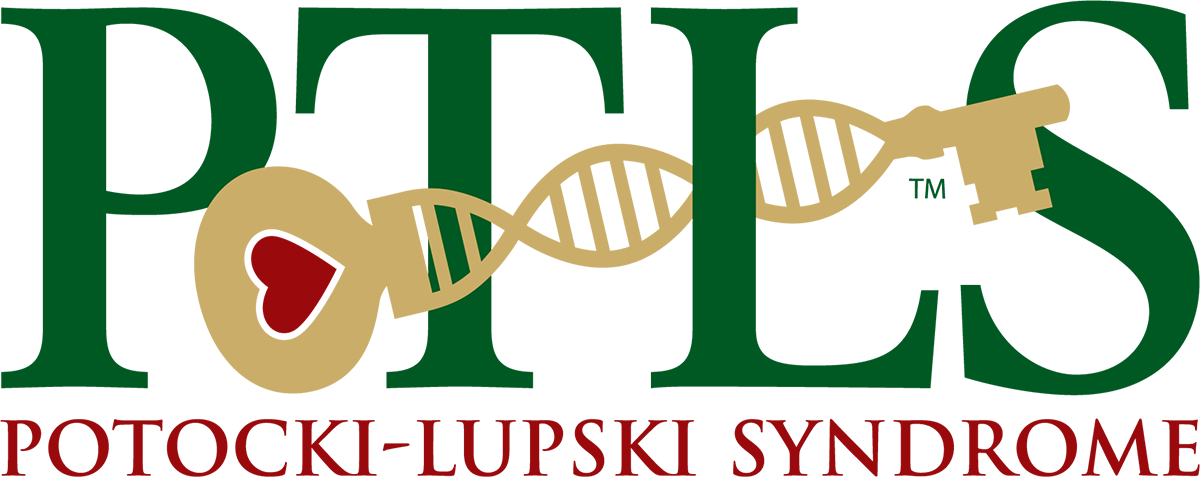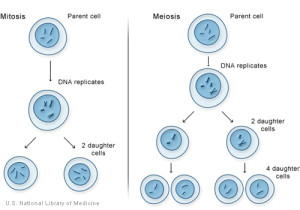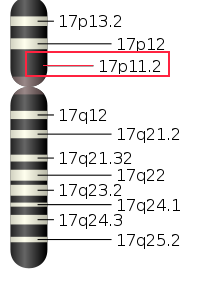To begin, one has to understand that each cell in the body contains long string-like structures, called chromosomes. We have 46 chromosomes; 22 pairs of autosomes, and 1 pair of sex chromosomes. Packed inside of each of these is our DNA. When the DNA or chromosomes are altered or damaged, or if the number of copies of any given gene or chromosome is altered (i.e. too many or too few), then medical and developmental problems can occur.
Meiosis- This is the cell division process that produces the sperm and the egg. Each carries half of the 46 chromosomes, which is 23, so when the sperm and egg meet at conception the total is restored to 46. This is why someone with a chromosome abnormality has a 50/50 chance of passing down traits o their children. Much can happen during the process of meiosis as the chromosomes and the DNA inside can have trouble matching up in the right order, causing pieces of the chromosomes to break off, duplicate or delete. This is what happens with dup17p11.2, known as Potocki-Lupski Syndrome (PTLS).
During meiosis, the DNA strands do not line up properly and the result is an egg or a sperm with either too much (dup17p11.2—PTLS) or too little (del17p11.2—Smith-Magenis Syndrome) DNA. If the egg (or sperm) with the duplication becomes fertilized (or fertilizes) then all the cells that develop will have the duplication too (see Mitosis, pictured above).
Genes- These are the little segments of inherited information (humans have about 20,000 genes!) packed in the DNA bands, which are found in the chromosomes. These are the specific pieces of information that tell our body how to behave. Are we going to be tall, short, will our hair be brown or blond, will our eyes be green or brown? And now geneticists can find out if we are at risk for various other conditions, such as cancer, heart condition, and other health concerns. They are learning more every day. This is how the doctors know that there is a link to the “skinny gene” or cholesterol lowering ability, give instructions on how the cells will migrate in the brain, give the long intestine, Aortic root concern, kidney structure issue, low muscle tone, scoliosis, and so much more the doctors have been able to identify over many years in just our little region of the 17p11.2 region. What Dr. Lupski and Dr. Potocki have found is that the gene, known as RAI1, is the one important regulatory gene found in PTLS.
DNA- This is the molecule that codes for all the genetic information. The molecule is in the configuration of a “double helix,” which is organized into structures called chromosomes.
The 17p11.2 region is duplicated in PTLS, this means that individuals with PTLS have 3 copies of this region instead of the normal 2 copies. This can sometimes be seen on a routine chromosome analysis, but now a days, most diagnoses are made by a newer technology called chromosome microarray test, which does not rely on the geneticist’s vision to find the duplication!
Chromosomes- These are the structures that look like an “X” when you look up Chromosome. It is what houses the DNA with the genes in them. The 46 chromosomes are seen in pairs (one of each pair from the mother’s egg, and one from the father’s sperm) and numbered 1-22 and the 23 rd pair shows the sex of the baby (XX for girls and XY for boys).
When you look at a chromosome you will notice that there is a constriction near the middle of each one. The region above this constriction is usually shorter than the region below— thus, the region above is called the “short arm” of the chromosome. The letter “p” designates this arm (“p” stands for petite). The region below is called the “long arm”. Since “q” is the next letter of the alphabet, the long arm is called the “q” arm. You will also notice black, white, and grey stripes along each chromosome. These are called “bands”. PTLS is due to a duplication of band 11.2 in the short arm of chromosome 17—or “dup17p11.2” !!!
Syndrome- The term “syndrome” refers to the collection of physical, behavioral and medical features which are common to individuals who share the same genetic or chromosomal make-up, or complement. This syndrome is made of similar disorders of concern (feeding, developmental, behavioral, and physical concerns, to name a few). Many of these medical and developmental conditions can be treated by therapy (e.g.: oral- motor therapy), surgery (e.g.: heart surgery to fix a heart defect), or medication (e.g.: medication to prevent further dilation of the aortic root).
In summary: Potocki-Lupski Syndrome (PTLS) results when either the sperm or the egg has a duplication of 17p11.2. From there, a beautiful PTLS child matures with the instructions in each cell directing the cell to behave in a certain manner (A person with PTLS has 3 copies of the 17p11.2 region). Medical and developmental conditions which are more common in PTLS then in the general population include heart defects, poor feeding and failure to thrive, autism, and intellectual disability. Duplication 17p11.2, known as Potocki-Lupski Syndrome (PTLS) is NOT a disease, but a syndrome, or constellation of developmental differences which can vary amongst individuals.
Author: J.Smith-Centeno, L.Potocki, P.Magoulas. 2013




Add a Comment
You must be logged in to post a comment